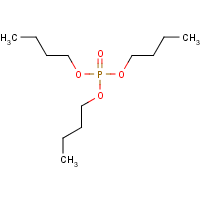Tributyl phosphate
Agent Name
Tributyl phosphate
CAS Number
126-73-8
Formula
C12-H27-O4-P
Major Category
Other Classes

Synonyms
Butyl phosphate; Butyl phosphate, ((BuO)3PO); Butyl phosphate, tri-; Celluphos 4; Disflamoll TB; MCS 2495; Phosphoric acid, tributyl ester; TBP; Tri-N-butylphosphate; Tri-n-butyl phosphate; Tributilfosfato [Italian]; Tributoxyphosphine oxide; Tributyl phosphate; Tributyle (phosphate de) [French]; Tributylfosfaat [Dutch]; Tributylfosfat [Czech]; Tributylphosphat [German]; Tributylphosphate; [ChemIDplus]
Category
Organophosphates, Other
Description
Colorless to pale-yellow, odorless liquid; [NIOSH]
Sources/Uses
Mainly used as a flame retardant in aircraft hydraulic fluid, which can contain 25 to 75% TBP; Also used as a solvent (rare earth extraction and nuclear fuel cycle), plasticizer, carrier for fluorescent dyes, and antifoam agent (cement casings for oil wells); [ACGIH] Used as an antifoaming agent (concrete, textile, and paper industries); [HSDB]
Comments
"TLV Basis" is bladder, eye, and upper respiratory tract irritation; Animals given repeated oral doses show necrosis, hyperplasia, and subsequent neoplasia of the urinary bladder epithelium with a NOEL of 9-12 mg/kg/day equivalent to a worker exposed by inhalation to 63-84 mg/m3; In lethal dose studies, animals have mild anesthesia, pronounced weakness, and respiratory failure; In inhalation studies, serum cholinesterase activity is depressed on the day after exposure; No evidence of nerve damage (OPIDN) in standard protocols testing chickens; [ACGIH] If left on clothing, can cause reddening of skin; [CHRIS] Irritating to the skin, eyes, and respiratory tract; [ICSC]
Biomedical References
Exposure Assessment
BEI
Acetylcholinesterase activity in red blood cells = 70% of individual's baseline; Butylcholinesterase activity in serum or plasma = 60% of individual's baseline; Sample at end of shift; [TLVs and BEIs]
Skin Designation (ACGIH)
Insufficient data
TLV (ACGIH)
5 mg/m3, inhalable fraction and vapor
PEL (OSHA)
5 mg/m3
MAK
11 mg/m3
IDLH (NIOSH)
327 mg/m3
Excerpts from Documentation for IDLHs
"Human data: Nausea and headache have been reported in workers exposed to 15 mg/m3 (1.4 ppm) [Mastromatteo 1964]." [NIOSH]
Vapor Pressure
0.00113 mm Hg
Lethal Concentration
LC50 (rat) = 28,000 mg/m3/1H
Explanatory Notes
Flash point = 146 deg C;
NFPA
must be preheated
Adverse Effects
ACGIH Carcinogen
Confirmed Animal
Diseases, Processes, and Activities Linked to This Agent
Processes
Industrial Processes with risk of exposure: